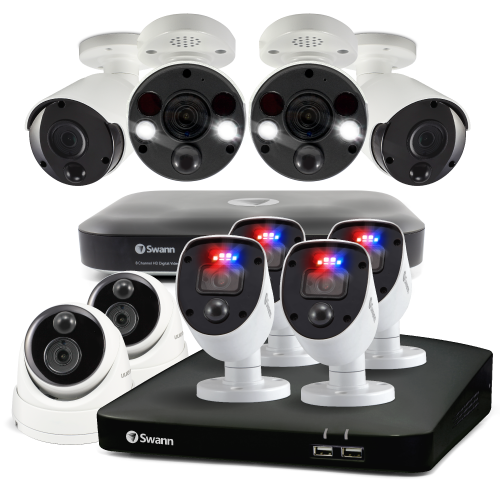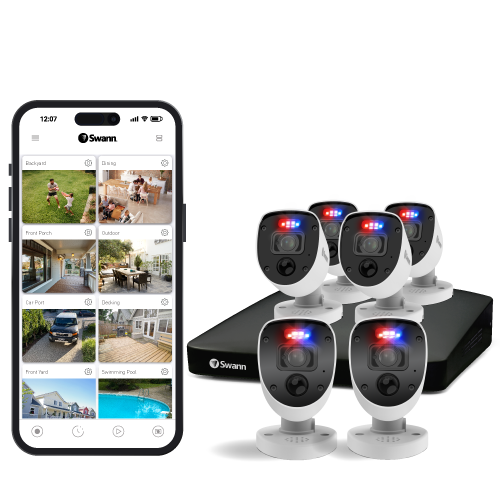
Proven Protection with a DVR Security System
Shop DVR security camera systems, available from Swann in 1080p or 4K resolution, for peace of mind from every angle.
DVR Security Camera Systems
Browse DVR Systems

Get a DVR Surveillance System for 24/7 Security
Time-tested DVR security systems have been catching and deterring thieves for over 50 years. Swann is bringing this reliable wired technology into the 21st century with modern advancements like True Detect heat and motion alerts, infrared night vision, 4K Ultra HD resolution, and more on select systems. Find the right choice for you by exploring our many four, six, eight, or up to sixteen camera DVR systems.
-
What are DVR security systems?
DVR (Digital Video Recorder) systems are traditional camera surveillance systems using analog cameras, coaxial cables, and a DVR recorder. The analog cameras connect to the recorder through the coaxial cables, transmitting unprocessed video signals. Once the signals reach the recorder, they can be processed and made available for digital viewing.
-
How are DVR security systems different from NVR systems?
DVR and NVR surveillance systems use different types of cameras, shaping how each system operates. DVR systems use analog cameras that connect to a DVR using coaxial cable. The video signals from the cameras are converted from analog to digital by the recorder.
NVR systems, on the other hand, use advanced IP, or internet protocol, cameras. These cameras can process video data themselves, instead of relying on the recorder to convert footage, allowing for wireless transmission.
This gives NVR systems greater flexibility, as they can operate either wirelessly or with Ethernet cables. DVR surveillance systems are strictly wired – there are no wireless DVR security systems.
-
What are the benefits and drawbacks of DVR systems?
The main benefit of a DVR camera system is the cost. DVR systems are significantly more affordable than NVR systems, mainly due to the lower cost of analog cameras. This savings is especially appealing if you’re unsure about incorporating Wi-Fi into your security network.
If you have spotty internet, no internet, or Wi-Fi security concerns, a DVR system may be a better choice for you than a wired NVR system. DVR systems are dependable, affordable, and relatively straightforward. And, with recent advancements in analog high definition, the gap in quality between NVR and DVR systems has significantly lessened.
However, if you’re still looking for something more advanced or with greater flexibility, DVR surveillance systems may not be for you. DVR systems tend to have lesser flexibility, picture quality, ease of installation, and audio capabilities than their NVR counterparts.
-
How many cameras can I connect to my DVR recorder?
The number of cameras, or channels, that a recorder can support depends on the specific model. Swann DVR recorders can support anywhere from 4 to 16 channels.
-
How do I see the video footage?
The Swann Security app for iOS or Android allows you to access live or playback video wherever you are. NVR systems come with a hard drive to locally store (usually up to 2TB of) data. There is also the option to back up some of the camera footage on the cloud.
-
How long will my footage be available on the recorder?
Swann DVR recorders have massive 1-2TB hard drives, allowing for footage to be stored for up to one year at no additional cost to you.
-
How can I permanently save footage?
You can permanently save images and video in your personal Dropbox account in the cloud, or transfer footage to a USB memory stick or hard drive for safekeeping.
-
If I buy a Swann DVR System are there any monthly fees to worry about?
No. There are no ongoing fees to install and operate your system and there is ample free local storage included with every Swann DVR.
-
What internet speed do I need for a wired DVR camera system?
Multi-stream wired surveillance systems typically require broadband internet connection at the premises where the cameras are located with upload bandwith of 2Mbps or greater.